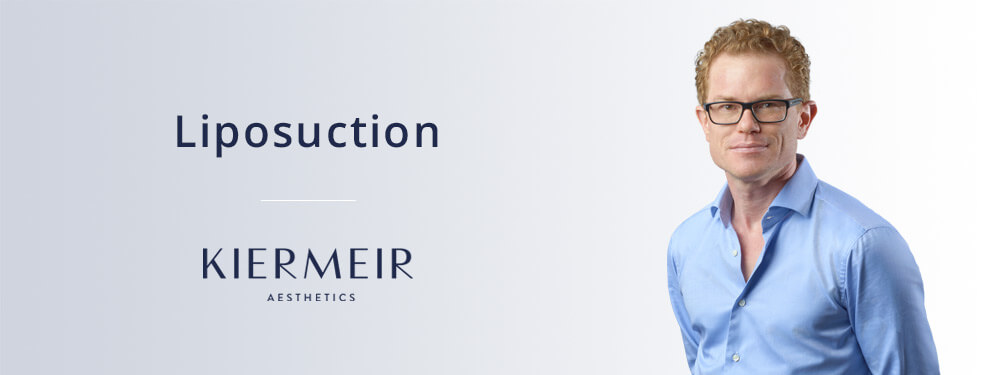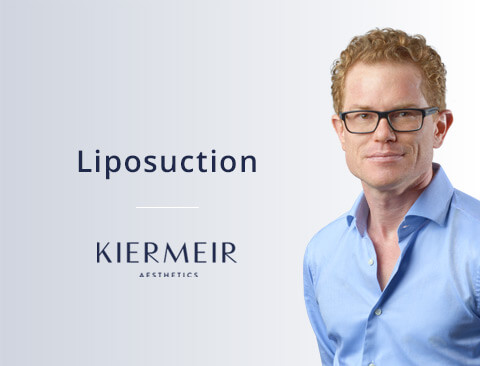Liposuction in Bern

Dr. med. David Kiermeir
Specialist for plastic, reconstructive and aesthetic surgery (FMH)
more than 15 years of surgical experience
since 12 years exclusively active in the field of plastic and aesthetic surgery
over 6,000 performed surgeries
Facts on Liposuction
| Treatment duration: | approx. 1 - 3 hours |
| Anaesthesia: | local anaesthetic / twilight sleep / general anaesthetic on request |
| Hospital stay: | outpatient or stationary for 1 - 2 days |
| Removal of sutures: | not necessary |
| Sports: | after approx. 2 weeks |
| Costs: | from CHF 3.500 |
Remove stubborn deposits with liposuction
There are some fat deposits in our bodies that exercise and diets simply can’t resolve because they’re caused by genetic factors. One typical location for such fat deposits are a person’s thighs, where the fat on the inside and outside of the upper legs can almost take on the appearance of riding breeches. Unwanted flabby areas can also develop around the abdomen and on a person’s sides. Liposuction is required to remove such fat deposits.
A precondition for liposuction is that the patient’s skin has a good degree of elasticity. In liposuction, cells in the lower layers of fat tissue are permanently eliminated. Liposuction therefore serves to correct and enhance the contours of a person’s body, though it does not result in significant weight reduction.
Frequently asked questions on liposuction
Incisions of roughly 3mm in length are made in the problem areas in order to remove the unwanted fat cells. These incisions are used to inject a solution containing a local anaesthetic and an adrenalin supplement into the fat tissue. Doing so ensures that the liposuction is almost completely painless for the patient. It also prevents any bruising and reduces blood loss during the operation. The fat is extracted using fine cannulas with a diameter of 3–4 millimetres.
To ensure the instruments can penetrate the fat tissue effectively and shape it precisely, the surgeon uses a liposuction device fitted with an oscillating cannula tip. This method is not only used to remove fat deposits from the thighs and stomach, but is also a highly effective treatment for other parts of the body. It can be used to treat a double chin or remedy an oversized chest in men or remove excess fat from the upper arms. Liposuction can also reduce fat deposits in the knees, lower legs or the throat and neck.
We have the technology to perform water-jet-assisted liposuction, which makes it possible to remove the fat tissue in a particularly gentle manner. This is important if we’re seeking to transfer the fat tissue to a different location, as we want as many cells as possible to survive. We use the water-jet-assisted liposuction technique when collecting fat tissue to augment a patient’s breasts, for instance, or when transferring fat to their face. As with conventional liposuction techniques, the fat tissue is accessed via small incisions and extracted using cannulas.
A precisely prepared special tumescent solution is injected at the same time. After the fat has been extracted and the target area prepared accordingly, the fat tissue can be transplanted back into the patient, for instance to augment their breasts or add volume to their face. This step does not create any additional scarring to the face or breasts. For women who have specific problem areas and also want a non-scarring breast augmentation, fat transfers can be an elegant solution to both problems.
Liposuction takes between 1–3 hours depending on the scope involved. We perform the procedure under local or regional anaesthetic with twilight sedation, or under general anaesthetic at the patient’s request. After the procedure, patients are usually able to leave our clinic in Bern the same day. However, more extensive procedures require an inpatient stay in our clinic. As we administer a powerful local anaesthetic, patients will only feel mild pains that feel similar to aching muscles around 12 to 24 hours after the procedure. Such complaints can be easily managed and masked with common painkillers.
Patients must wear compression tights at all times for the first week following the operation. After this time, any bruising and swelling will usually have receded to the point that the compression tights are no longer needed. In the following 6 to 12 months, the newly formed tissues scar over and become firmer. It’s only at this point that the final treatment results can be assessed. If the patient gains weight again in future, the fat will no longer gather exclusively in their past problem areas.
Fat removal procedures can result in asymmetries. It’s also not always possible to avoid creating waves and bumps in the skin. As a result, further corrective procedures are required in under 10% of cases. Even less frequently, patients experience secondary haemorrhaging or collections of tissue fluid, which can then be punctured. Scarring and circulatory issues are also possible, as are infections.
To keep these risks to a minimum, you should rest for a period of at least 1–2 weeks after the operation. You should avoid any physical strain, such as exercise, for 2–3 weeks.
CONTACT
Opening hours
| Monday | 8.00 a.m. - 5.00 p.m. |
| Tuesday | 8.00 a.m. - 5.00 p.m. |
| Wednesday | 8.00 a.m. - 5.00 p.m. |
| Thursday | 8.00 a.m. - 5.00 p.m. |
| Friday | 8.00 a.m. - 4.00 p.m. |
and by appointment



